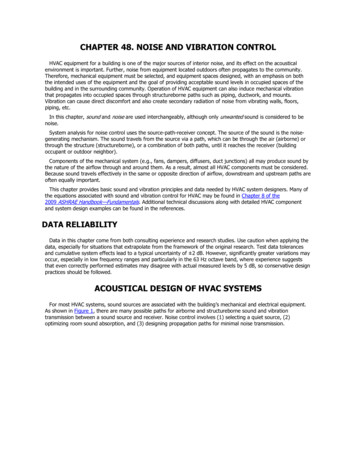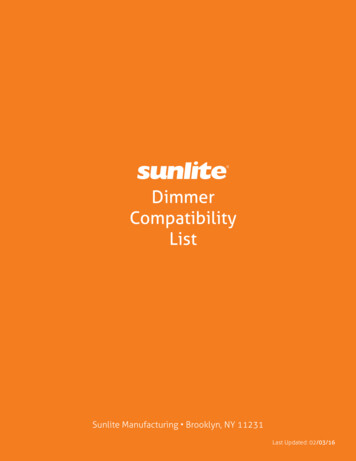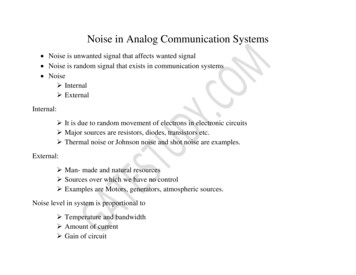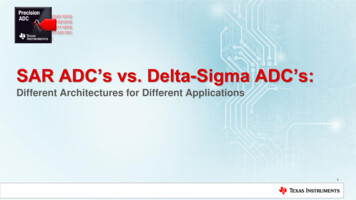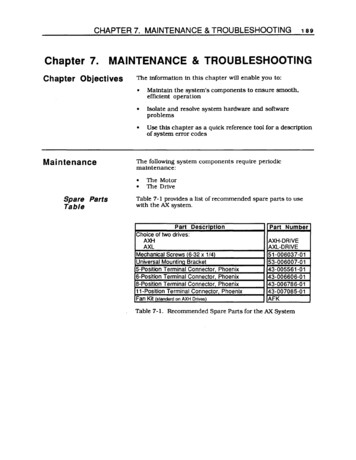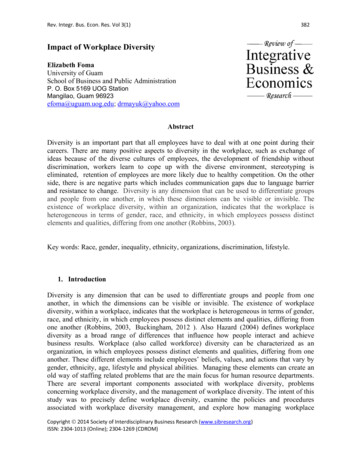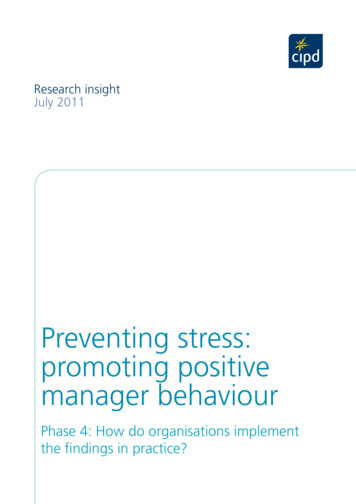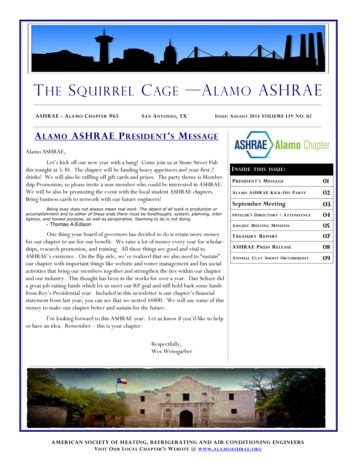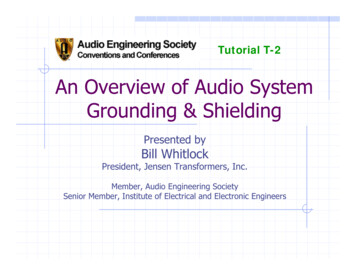
Transcription
Preventing HazardousNoise and Hearing Lossduring Project Designand OperationPrevention throughDesign (PtD)Prevention through Design (PtD)can be defined as designing outor eliminating safety and healthhazards associated with processes,structures, equipment, tools, orwork organization. The NationalInstitute for Occupational Safetyand Health (NIOSH) launched aPtD initiative in 2007. The missionis to reduce or prevent occupationalinjuries, illnesses, and fatalities byconsidering hazard prevention inthe design, re-design, and retrofit ofnew and existing workplaces, tools,equipment, and work processes[NIOSH 2008a,b].Contents Why is PtD Needed Summary Description of Exposure Workers at Risk Exposure Limits Protecting Workers fromHearing Loss Case Studies Recommendations Acknowledgments ReferencesWhy is PtD Needed? Description ofExposureIntegrating PtD concepts into business processes helps reduce injury andillness in the workplace, as well as costsassociated with injuries. PtD lays thefoundation for a sustainable culture ofsafety with lower workers’ compensationexpenses, fewer retrofits, and improvedproductivity. When PtD concepts are introduced early in the design process, resources can be allocated more efficiently.SummaryExposure to high noise levels in theworkplace can cause hearing loss andaffect worker productivity and compensation costs. This document describescase studies in which noise controlswere implemented that reduced workernoise exposure. NIOSH recommendsconsidering PtD concepts and incorporating engineering noise controls duringthe project design phase of processesand operations.Prolonged exposure to high noise levelscan cause hearing loss and tinnitus.Other health effects include headaches,fatigue, stress, and cardiovascularproblems [Yueh et al. 2003]. High noiselevels can also cause workers to be distracted and interfere with communication and warning signals. If workers donot hear warning signals, they may nottake precautions to prevent hazards orinjuries [NIOSH 1996, 1998; Yoon et al.2015; Cantley et al. 2015].Workers at RiskAn estimated twenty-two million workers are exposed to potentially damaging noise each year [NIOSH 2014a].Although any worker can be at riskfor noise-induced hearing loss in theworkplace, workers in agriculture, mining, construction, manufacturing andutilities, transportation, and the militaryare at greater risk [Masterson et al. 2013;NIOSH 2001].DEPARTMENT OF HEALTH AND HUMAN SERVICESCenters for Disease Control and PreventionNational Institute for Occupational Safety and Health
Exposure LimitsIn the United States, occupational regulations and standards were establishedto protect workers against the healtheffects of exposure to hazardous substances and agents when certain values,or limits, are reached. NIOSH establishesrecommended exposure limits (RELs)for various hazards, but those limits arenot enforceable by law; they are basedon best available science and practices.The REL for noise is 85 decibels, usingthe A-weighting frequency response overan 8-hour average, usually referred toas time-weighted average (TWA); exposures at or above this level are consideredhazardous [NIOSH 1998]. The Occupational Safety and Health Administration(OSHA) sets legally-enforceable permissible exposure limits (PELs) that requireemployers to take actions to reduce workerexposures. The OSHA PEL for noise is 90dBA as an 8-hr TWA [29 CFR* 1910.95].Occupational standards specify a maximum allowable daily noise dose, expressedin percentages. For example, a person exposed to 85 dBA per NIOSH or 90 dBA perOSHA over an 8-hour work shift, will reach100% of their daily noise dose. The noisedose is based on both the sound exposurelevel and how long it lasts (duration) so foreach increase of 3-dB (NIOSH) or 5-dB(OSHA) in noise levels, the duration of the*Code of Federal Regulations. See CFR inReferences.exposure should be cut in half (these arereferred to as exchange rates in standards).Table 1 illustrates the relationship betweensound exposure levels and durations forboth NIOSH and OSHA.The Mine Safety and Health Administration (MSHA) PEL for miners is 90 dBA.If a miner’s noise exposure continues toexceed the PEL despite the use of engineering and administrative controls, themine operator must continue to use theengineering and administrative controls toreduce the miner’s noise exposure to as lowa level as is feasible [30 CFR § 62.130].is the most effective way to reduce noiselevels in the workplace [NIOSH 2001].According to the hierarchy of /), such measures take precedence overusing personal protective equipment suchas earplugs [NIOSH 2015].Protecting Workersfrom Hearing LossCase StudiesNoise-induced hearing loss (NIHL)is 100% preventable; however, onceacquired, it is permanent and irreversible [NIOSH 1998]. Understanding andminimizing the risks are the keys topreventing noise-related injuries andhearing loss. Eliminating or loweringfacility and equipment-related noise at thesource reduces the risks related to NIHLand results in improved safety, productivity, and comfort [Tak et al. 2009].The best way to reduce noise exposure andreduce resulting hearing loss is to addressnoise at the source by considering PtDprinciples. “Engineering out” hazardousnoise found in the workplace before theexposure occurs (e.g., by installing quieterequipment or building an acoustic barrier)Table 1. The average sound exposure levels needed to reach themaximum allowable daily dose of 100%Time to reach100% noise doseExposure levelper NIOSH RELExposure levelper OSHA PEL8 hours85 dBA90 dBA4 hours88 dBA95 dBA2 hours91 dBA100 dBA1 hour94 dBA105 dBA30 minutes97 dBA110 dBA15 minutes100 dBA115 dBAThese noise reduction measures can lowercosts associated with workers’ compensation for hearing loss, protect workers’hearing, and improve productivity. Costsassociated with retrofitting noisy equipment are also no longer necessary.The following case studies demonstratehow small design and operational changescan reduce noise levels and reduceassociated costs.Case Study 1Compressed air is often the most common noise source in manufacturing plantsand other industries. It is used to operateequipment, such as air cylinders, air valves,solenoids, etc., or move parts/product,blow off debris, close flaps on corrugatedcontainers (boxes/cases), or perform similar service-type actions. The noise generated by compressed air is caused by turbulence from the mixing of gases with widelydifferent velocities, particularly when thehigh-velocity air stream flows into therelatively still surrounding air. Additionalturbulence is created as the compressed airblows against objects, such as parts or sections of the machinery.Compressed air noise can be controlledby reducing the air velocity to as low aspractical while maintaining performancerequirements and by treating all openended discharge lines and ports, includingstandard air jets and nozzles with commercially-available quiet-design nozzles orpneumatic silencers [IRSST 2015].Addressing the noise produced by compressed air provides the greatest noisereduction per dollar invested, and can evenhave a payback in dollars through energysavings and life expectancy of equipment.Blowing compressed air through a 3/8-inchopen pipe at a pressure of 71.5 pounds per
square inch (psi) uses 109 standard feetper cubic minute (scfm). At an averagecost of 0.015 per 35.3 standard cubic feet(scf), and an estimated use time of 40%,this equates to 704 hours of consumptionper year. Therefore, the annual cost for theopen pipe is: 109 ft3/min x 0.015/35.3 ft3 60 min /hr 704 hours 1956.44. By using a quiet-design nozzle that provides thesame air-flow service, but only uses 55.9scfm, the resulting annual cost would be 1003.35, a savings of 953.09 per nozzlewhile reducing noise levels by 20 dBA[Driscoll 2011].This approach was successfully demonstrated by two of the Safe-in-Sound Excellence in Hearing Loss Prevention Award (www.safeinsound.us) recipients. One ofthe recipients (Colgate-Palmolive Company) created a guidance document to optimize system operation, minimize air leaksand provide guidance on appropriate use ofair tools. (http://www.safeinsound.us/swf/colgate/). This effort involved (1) measuring, documenting, and optimizing airpressure settings for all pneumatic devices,(2) maintaining the pneumatic equipmentand monitoring the optimized settingsover time, and (3) locating and repairingcompressed air leaks from cracked hoses,failed seals, etc. At the beginning of theimplementation phase, worker doses werereduced from 113 to 90 dBA 8-hr TWA,and energy consumption was also reduced.This was also one of the approaches takenby another Safe-in-Sound recipient (UnitedTechnologies) (http://www.safeinsound.us/swf/UTC/index.html) who reduced workernoise doses from 90 to 85 dBA†.Case study 2A NIOSH investigation of the sound levelsin the truck cab of an air-rotary drilling rig(see Figure 1) found that workers had exposure levels between 91 to 112 dBA. Testswere conducted to identify and isolate thedominant noise sources. Isolating the causeof the in-cab noise indicated that vibrationswere transmitted from multiple hydraulicpumps to the control panel producing theMore information about the awards andproceedings from the conference can befound in Meinke et al. 2013.†Figure 1. Track mounted, air rotary drill rigdominant spike in the sound level spectrum. The researchers also conducted fieldtests to evaluate noise controls to reducein-cab sound levels. Hydraulic noise suppressors were successfully used to reducethe structure-borne noise that is transmitted from the structure to the control panel.Further, the hydraulic noise suppressorsand enhanced soundproofing lessened therisk of hearing loss for workers by reducing the in-cab exposure levels by as muchas 4 dBA at high idle and by 1 dBA whenthe rig was hammer drilling. Covering agap at the cab/inside door interface withlead-fiberglass blankets further reducednoise levels by 3 dBA compared withbaseline conditions [Yantek et al. 2007].Case study 3Continuous mining machines are usedto cut and gather coal. These machinescontain an onboard conveyor consistingof a chain with flight bars that drag thecoal along the base of the conveyor system.The traditional machine chains and flightbars generate excessive noise when theyvibrate against the metal base. Becauseof the higher noise levels, mine operatorsworking near these machines are at greaterrisk of developing NIHL. The flight barsand the conveyor belt tail rotor were coatedwith a thick, durable urethane coating toreduce noise and improve the lifespan ofthe equipment. The redesigned chain andflight bars reduced sound levels by 6-7dBAat the operator ear. The reduction in noiseallowed the noise exposure to remainwithin the MSHA PEL [NIOSH 2009].RecommendationsTo reduce the incidence and severity ofwork-related hearing loss, NIOSH recommends hearing conservation programsfor all workplaces with noise levels thatexceed the REL of 85 dBA. In most cases,the preferred approach to reduce noise inthe workplace is to eliminate or reduce thesource of noise and to follow the hierarchyof controls [NIOSH 2014b; 2015]. NIOSHrecommends the following at each stage ofthe design process:Conceptual Design: Identify and applyrelevant noise control regulations, consensus standards, and codes to establishproject noise emission goals.
Preliminary Design: Assess the risk fornoise hazards, factoring in noise from various sources that can affect workers’ overallnoise exposures and develop risk controlalternatives.are controlled as new equipment is introduced or existing equipment is modified.Equipment noise levels should be notedpost-maintenance and periodically in theBuy Quiet documentation.Identify noise sources and work processesthat have the potential to contribute to aworker’s overall noise exposure. Eliminateor reduce potential noise sources by substituting quieter processes, elements, parts,and equipment.AcknowledgmentsBuy-Quiet: Implement a Buy Quietprogram and set design specificationsregarding noise levels to be adhered to inequipment purchasing decisions [NIOSH2014c]. Develop equipment specificationsthat will be included in procurement documents. Develop test protocols for factoryacceptance testing and commissioning.Procurement: In accordance with BuyQuiet program implementation, ensurenoise levels of all equipment purchases arespecified by the manufacturer. Gather likemodel equipment noise levels, specifications, and pricing from equipment suppliers. Accounting for operational needsand level of commitment to Buy Quietinitiatives, execute appropriate purchases.Ensure that purchased equipment meetsdesign specifications and doesn’t exceedmaximum noise levels as specified.Commissioning: Conduct tests toensure that specified noise levels havebeen achieved. Consider including thistesting in factory acceptance tests. Acceptance test data can be reported inA-weighted sound power level for smallmachines and A-weighted sound pressure level for large machines based onthe recommended operator position. Alltest measurements shall be made withmanufacturer-recommended operatingconditions [Hayden and Zechmann 2007].Start-up and Ongoing Operationsand Maintenance: Conduct noisesurveys to ensure that noise levels do notexceed the NIOSH REL of 85 dBA soundpressure level. Develop Standard operatingprocedures (SOPs) to maintain noise controls and ensure worker noise exposuresThe authors of this document areThais Morata, Ph.D. (NIOSH), CharlesHayden (NIOSH), Dennis Driscoll,P.E. (Principal Consultant, Associatesin Acoustics, Inc.), Carol M Stephenson, Ph.D. (NIOSH); Patricia M. Clegg(Health Resources Services Administration); and Susan Afanuh (NIOSH).ReferencesCFR. Code of Federal regulations.Washington, DC: U.S. GovernmentPrinting Office, Office of the FederalRegister. https://www.osha.gov/pls/oshaweb/owadisp.show document?ptable STANDARDS&p id 9735Cantley LF Galusha D, Cullen MR, DixonErnst C, Rabinowitz PM, Neitzel RL[2015]. Association between ambientnoise exposure, hearing acuity, and riskof acute occupational injury. Scand JWork Environ Health 41(1):75–83.Driscoll D [2011]. The economics of noisecontrol engineering versus the hearing conservation program. ProfessionalDevelopment Course. Portland, OR:2011 American Industrial Hygiene Conference & Exposition (AIHce). https://www.osha.gov/dts/osta/otm/new noise/appendixk.pdfHayden CS II, Zechmann E [2007].Estimation of sound pressure levelexposures from sound power levelmeasurements of powered handtools. Noise Control Eng J 55:4.IRSST [2015]. Choosing a safe, efficient blow gun. Montreal, Canada:Institut de Recherche Robert Sauvéen Santé et Securité au IRSST/RF-867.pdfMasterson EA, Tak S, Themann CL, WallDK, Groenewold, MR, Deddens JA,Calvert GM [2013]. Prevalence of hearing loss in the United States by industry.Am J Ind Med 56:670–681. 82/abstractMeinke D, Morata TC, Hayden C [2013].Noise control strategies: lessons fromSafe-in-Sound Excellence in Hearing Loss Prevention awards. Denver,CO: Proceedings of Noise-Con 2013.NIOSH [1996]. Preventing occupationalhearing loss—a practical guide. ByFranks JR, Stephenson MR, StephensonCJ. Department of Health and HumanServices, Centers for Disease Controland Prevention, National Institute forOccupational Safety and Health, DHHS(NIOSH) Publication No. 96-110. http://www.cdc.gov/niosh/docs/96-110/NIOSH [1998]. Criteria for a recommended standard: occupational noiseexposure. DHHS (NIOSH) PublicationNumber 98-126. dfNIOSH [2001]. Work-related hearing loss. DHHS (NIOSH) Publication No. 2001-103. http://www.cdc.gov/niosh/docs/2001-103/NIOSH [2008a].Prevention throughDesign: introduction. By Howard J. JSafety Research 39:113. fNIOSH [2008b]. National Preventionthrough Design (PtD) Initiative. BySchulte P, Rinehart R, Okun A, Geraci C,Heidel D. dfNIOSH [2009]. A dual sprocket chainas a noise control for a continuous mining machine. By KovalchikP, Smith A, Matetic R, Alcorn pdfs/adsca.pdfNIOSH [2014a]. NIOSH safety and healthtopic: noise and hearing loss IOSH [2014b]. NIOSH safety and healthtopic: noise control. lt.htmlNIOSH [2014c]. NIOSH safety andhealth topic: Buy Quiet components. .htmlNIOSH [2015]. NIOSH workplace safetyand health topic: hierarchy of /
Tak S, Davis RR, Calvert GM [2009].Exposure to hazardous workplacenoise and use of hearing protection devices among US workers—NHANES, 1999–2004. Am J Ind Med52:358–371. 690/abstract;jsessionid C6A7EEFA952F701624E48A959EF4C53D.f02t03, http://www.ncbi.nlm.nih.gov/pubmed/19267354Yantek D, Ingram D, Matetic R [2007].In-cab noise reduction on an airrotary drill rig. Noise Control Eng J55(3):294‒310. 2.htmlYoon JH, Hong JS, Roh J, Kim CN,Won, JU [2015]. Dose-responserelationship between noise exposure and the risk of occupationalinjury. Noise Health 17:43‒47.Yueh B, Shapiro N, MacLean CH, ShekellePG [2003]. Screening and management of adult hearing loss in primarycare: scientific review. J Am Med Assoc289(5):1976 1985. http://jama.jamanetwork.com/article.aspx?articleid 196401Suggested CitationNIOSH [2015]. Preventing hazardous noise and hearing loss during project design and operation. Morata T, Hayden C, Driscoll D,Stephenson CM, Clegg PM, Afanuh S. Cincinnati, OH: U.S. Department of Health and Human Services, Centers for Disease Controland Prevention, National Institute for Occupational Safety and Health, DHHS (NIOSH) Publication No. 2016-101.InformationThe information in this document is based on researchrelated to Prevention through Design (PtD) initiatives.More information about PtD is available on the NIOSHWebsite at http://www.cdc.gov/niosh/topics/PtD/Several noise control examples can be found among theSafe-in-Sound Excellence in Hearing Lossprevention Award recipients: http://www.safeinsound.us/winners.htmlFor more information about noise exposure andcontrol, visit: lt.html http://www.cdc.gov/niosh/topics/buyquiet/For more information about hearing loss, visit: http://www.cdc.gov/niosh/topics/noise/To obtain information about other occupational safetyand health topics, contact NIOSH at:Telephone: 1–800–CDC–INFO (1–800–232–4636)TTY: 1–888–232–6348 CDC INFO: www.cdc.gov/infoNovember 2015or visit the NIOSH website at www.cdc.gov/nioshFor a monthly update on news at NIOSH, subscribe toNIOSH eNews by visiting www.cdc.gov/niosh/eNews.Mention of any company or product does not constitute endorsement by NIOSH. In addition, citations to websites external to NIOSH do not constituteNIOSH endorsement of the sponsing organizations ortheir programs or products. Furthermore, NIOSH isnot responsible for the content of these websites.This document is in the public domain and may befreely copied or reprinted. NIOSH encourages all readers of the Workplace Design Solutions to make themavailable to all interested employers and workers.As part of the Centers for Disease Control and Prevention,NIOSH is the Federal agency responsible for conductingresearch and making recommendations to prevent workrelated illness and injuries.Publication No. 2016-101
sound exposure levels and durations for both NIOSH and OSHA. The Mine Safety and Health Administra-tion (MSHA) PEL for miners is 90 dBA. If a miner’s noise exposure continues to exceed the PEL despite the use of engi-neering and administrative controls, the mine operator must continue to use the
